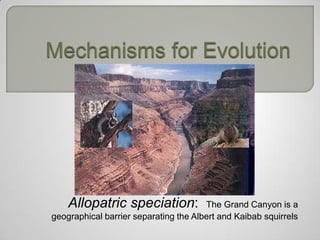
4 mechanisms for evolution 2012
- 1. Allopatric speciation: The Grand Canyon is a geographical barrier separating the Albert and Kaibab squirrels
- 2. Population – a group of organisms that interbreed Each population shares a gene pool (the different alleles present in the population) Each population has a relative frequency of each alleles, or the number of times the allele occurs in the gene pool. The frequency of alleles in a population tend not to change unless there is an outside force causing it
- 3. Mutations are inheritable changes to the genotype of an organism Mutations occur randomly and spontaneously within a population Most mutations are harmful, but some are useful Mutations can affect allele frequency in a population by 1. Adding new alleles for a trait 2. Changing the amount of each allele present It can take a long time to eliminate a mutation and a long time for a new mutation to become prevalent
- 4. There are 5 mechanisms that can change the allele frequencies in a population 1. Mutation 2. Migration 3. Genetic Drift 4. Non-random Mating 5. Natural Selection
- 5. Movement into and out of a population can change the allele frequency in a population’s gene pool Immigration can ADD individuals with variations to the population Emigration can REMOVE individuals with variations from a population. Can you think of large human immigrations and emigrations within the last 150 years? Many species encourage migration which can cause more gene flow which is the process of transferring genes among different populations
- 6. Genetic drift is the random changes in allele frequency due to population size. In smaller populations the allele frequency can change more rapidly than in larger populations
- 7. The founder effect occurs when a few individuals from a larger population colonize a new area. • Ex. Amish community. The allele frequency of this population may differ from the larger population because of the limited number of individuals
- 8. Havinga limited number of individuals can also impact mating. Non random mating can influence allele frequencies because: • Mates can be limited by geography • Mates can be chosen for their traits • Mates can be more closely related to one another
- 9. Natural selection is process by which individual which are more fit for the environment survive and reproduce The interaction of populations and the environment results in changing allele frequencies There are 4 different types of natural selection: a. Stabilizing Selection b. Directional Selection c. Disruptive Selection d. Sexual Selection
- 10. Stabilizingselection occurs when individuals with the average form of the trait are most fit for the environment and extreme traits are eliminated This is the most common form of selection and works in all populations at all times
- 11. Lizard body size: • Large lizards are easily seen by predators, but smaller lizards cannot run as fast to escape the predators • Mid sized lizards are most fit in the environment, so they survive and reproduce more often, changing the allele frequencies in the population
- 12. Directionalselection occurs when individuals with one extreme of variations are the most fit in the environment. Thiscauses a gradual shift in allele frequency to that extreme.
- 13. Anteater tongue length: • Anteaters with long tongues are most fit because of the depth of the nests of the termites they eat.
- 14. Disruptive selection occurs when both extremes of variations are the most fit There is selection against the middle variations Ex: Limpet shells • Dark limpets blend with bare rocks • Light limpets blend with barnacle covered rocks • Tan limpets are visible in both situations and get preyed upon by birds
- 15. Sexual selection is the competition for mates within a population causing differences to occur in the allele frequencies of the 2 genders Matestend to be chosen for their phenotypes and females tend to choose the males.
- 16. Ex: Peacocks • Male peacocks have large tail feathers that make it difficult to fly and escape from predators • Female peacocks choose males based on their tail feather length and fullness • Over time males with larger tail feathers reproduce more causing large tails to be selected for • Sexual Selection in Peacocks (3 min.)
- 17. In evolutionary biology, adaptive radiation is the evolution of ecological and phenotypic diversity within a rapidly multiplying lineage.
- 18. Coevolutionary relationships mainly occur between plants and herbivorous insects and between plants and pollinating insects. Mutually beneficial relationship.
- 19. When organisms evolve similar (analagous) structures or functions even though their evolutionary ancestors are very dissimilar or unrelated. Example: The complex eyes of vertebrates, cephalopods (squid and octopus), cubozoan jellyfish, and arthropods (insects, spiders, crustaceans) evolved separately, but all perform the function of http://images.sciencedaily.com/2009/06/0 vision 90601182828-large.jpg http://jeffvrabel.files.wordpress.com/2011/08/wolf-spider-5-29-08- 7eyes.jpg
- 20. Look at the cladogram at the right. What conclusions can be drawn about the relationship between humans and chimps?
- 21. Note that this diagram is also a timeline. The older organism are located on the bottom of the tree. The four descendents at the top of the tree are DIFFERENT species. This is called SPECIATION.
- 22. Branches on the tree represent SPECIATION, the formation of a new species. The event that causes the speciation is shown as the fork of the “V”.
- 23. Did humans evolve from chimps? No What familial relationship is a good description of the relationship between chimps and humans? Distant Cousins Are humans more highly evolved than chimps? NO- since the lineage is split, each species has evolved unique traits.
- 24. With 98.4% similar genetic sequences chimpanzees are both a link to Kingdom Animalia and our kin. Anima: James Balog images used with permission. http://www.jamesbalog.com/